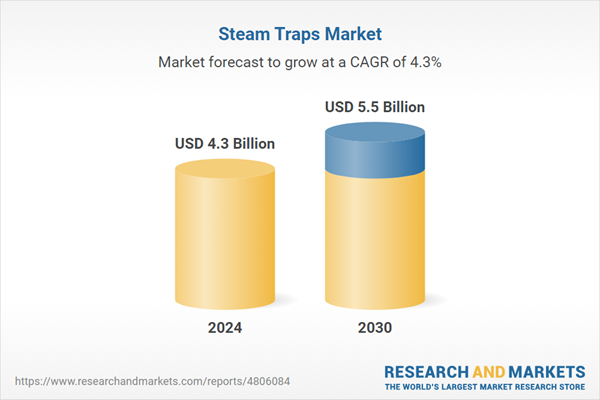The global market for Steam Traps was valued at US$4.3 Billion in 2024 and is projected to reach US$5.5 Billion by 2030, growing at a CAGR of 4.3% from 2024 to 2030. This comprehensive report provides an in-depth analysis of market trends, drivers, and forecasts, helping you make informed business decisions. The report includes the most recent global tariff developments and how they impact the Steam Traps market.
Segments: Product (Mechanical, Thermodynamic, Thermostatic); Type (Tracing, Drip, Process).
Geographic Regions/Countries: World; United States; Canada; Japan; China; Europe (France; Germany; Italy; United Kingdom; Spain; Russia; and Rest of Europe); Asia-Pacific (Australia; India; South Korea; and Rest of Asia-Pacific); Latin America (Argentina; Brazil; Mexico; and Rest of Latin America); Middle East (Iran; Israel; Saudi Arabia; United Arab Emirates; and Rest of Middle East); and Africa.
The analysts continuously track trade developments worldwide, drawing insights from leading global economists and over 200 industry and policy institutions, including think tanks, trade organizations, and national economic advisory bodies. This intelligence is integrated into forecasting models to provide timely, data-driven analysis of emerging risks and opportunities.
Global Steam Traps Market - Key Trends and Drivers Summarized
Why Are Steam Traps Essential in Industrial Steam Systems?
Steam traps are essential components of industrial steam systems, designed to discharge condensate, air, and non-condensable gases while preventing the loss of live steam. By maintaining the efficiency and reliability of steam distribution networks, steam traps help optimize energy consumption, reduce operational costs, and enhance process performance. They are widely used in industries such as petrochemical, pharmaceutical, food processing, and HVAC, where steam is a critical utility for heating, drying, sterilization, and power generation. The growing emphasis on energy conservation, efficiency improvement, and emission reduction is driving the demand for high-performance steam traps that can minimize steam leakage, water hammer, and system downtime, ensuring optimal steam system operation.How Are Innovations in Steam Trap Technologies Enhancing Steam System Efficiency?
Innovations in steam trap technologies are enhancing the efficiency, reliability, and longevity of steam systems, driving their adoption in various industrial applications. The development of smart, automatic, and self-monitoring steam traps is addressing the need for real-time performance monitoring, fault detection, and predictive maintenance, reducing maintenance costs and downtime. Advanced steam traps, such as thermostatic, thermodynamic, and mechanical types, are offering improved energy efficiency, reliability, and adaptability to different operating conditions. The integration of Internet of Things (IoT) sensors, data analytics, and remote monitoring in steam trap management systems is enabling proactive steam management, enhancing process control, and optimizing energy use in steam systems.Which Market Segments Are Leading the Growth of the Steam Traps Industry?
Types of steam traps include thermostatic, thermodynamic, mechanical, and venturi, with thermostatic traps holding a large market share due to their efficiency, reliability, and wide range of applications. Applications of steam traps span condensate discharge, steam tracing, process heating, and pressure reduction, with condensate discharge being the dominant segment due to the high demand for energy conservation and efficiency improvement. End-use industries include petrochemical, pharmaceutical, food and beverage, power generation, and HVAC, with petrochemical and pharmaceutical industries leading the market due to their need for efficient steam management and process control. Geographically, North America, Europe, and Asia-Pacific are the largest markets for steam traps, driven by strong industrial growth, increasing focus on energy efficiency, and rising environmental awareness.What Are the Key Drivers of Growth in the Steam Traps Market?
The growth in the steam traps market is driven by several factors, including rising demand for energy conservation, efficiency improvement, and reliability in steam systems, technological advancements in steam trap design, automation, and remote monitoring, and the increasing adoption of smart, automatic, and self-monitoring steam traps in various industries. The need to provide efficient, reliable, and cost-effective steam management solutions for various applications is driving the demand for steam traps across multiple sectors. Technological innovations in thermostatic, thermodynamic, mechanical, and venturi steam traps, coupled with advancements in IoT sensors, data analytics, predictive maintenance, and digital twins, are enhancing the performance, efficiency, and marketability of steam traps, supporting market growth. The expansion of steam trap applications in food processing, power generation, chemical processing, and HVAC, along with the growing emphasis on reducing steam losses, operational costs, and carbon footprint, is creating new opportunities for market players. Additionally, the focus on developing advanced, high-performance, and sustainable steam trap solutions for diverse steam systems is further propelling the growth of the steam traps market.Report Scope
The report analyzes the Steam Traps market, presented in terms of units. The analysis covers the key segments and geographic regions outlined below.Segments: Product (Mechanical, Thermodynamic, Thermostatic); Type (Tracing, Drip, Process).
Geographic Regions/Countries: World; United States; Canada; Japan; China; Europe (France; Germany; Italy; United Kingdom; Spain; Russia; and Rest of Europe); Asia-Pacific (Australia; India; South Korea; and Rest of Asia-Pacific); Latin America (Argentina; Brazil; Mexico; and Rest of Latin America); Middle East (Iran; Israel; Saudi Arabia; United Arab Emirates; and Rest of Middle East); and Africa.
Key Insights:
- Market Growth: Understand the significant growth trajectory of the Mechanical segment, which is expected to reach US$2.6 Billion by 2030 with a CAGR of a 4.8%. The Thermodynamic segment is also set to grow at 4.0% CAGR over the analysis period.
- Regional Analysis: Gain insights into the U.S. market, valued at $1.1 Billion in 2024, and China, forecasted to grow at an impressive 6.8% CAGR to reach $1.2 Billion by 2030. Discover growth trends in other key regions, including Japan, Canada, Germany, and the Asia-Pacific.
Why You Should Buy This Report:
- Detailed Market Analysis: Access a thorough analysis of the Global Steam Traps Market, covering all major geographic regions and market segments.
- Competitive Insights: Get an overview of the competitive landscape, including the market presence of major players across different geographies.
- Future Trends and Drivers: Understand the key trends and drivers shaping the future of the Global Steam Traps Market.
- Actionable Insights: Benefit from actionable insights that can help you identify new revenue opportunities and make strategic business decisions.
Key Questions Answered:
- How is the Global Steam Traps Market expected to evolve by 2030?
- What are the main drivers and restraints affecting the market?
- Which market segments will grow the most over the forecast period?
- How will market shares for different regions and segments change by 2030?
- Who are the leading players in the market, and what are their prospects?
Report Features:
- Comprehensive Market Data: Independent analysis of annual sales and market forecasts in US$ Million from 2024 to 2030.
- In-Depth Regional Analysis: Detailed insights into key markets, including the U.S., China, Japan, Canada, Europe, Asia-Pacific, Latin America, Middle East, and Africa.
- Company Profiles: Coverage of players such as Bestobell Steam Traps, a division of Richards Industries, Circor International, Inc., Emersion Electric Co., Flowserve Corporation, Pentair PLC and more.
- Complimentary Updates: Receive free report updates for one year to keep you informed of the latest market developments.
Some of the 24 companies featured in this Steam Traps market report include:
- Bestobell Steam Traps, a division of Richards Industries
- Circor International, Inc.
- Emersion Electric Co.
- Flowserve Corporation
- Pentair PLC
- Schlumberger Limited
- Spirax-Sarco Engineering plc
- The Weir Group PLC
- Thermax Ltd.
- Velan, Inc.
- Watson McDaniel Company
- Watts Water Technologies, Inc.
Tariff Impact Analysis: Key Insights for 2025
Global tariff negotiations across 180+ countries are reshaping supply chains, costs, and competitiveness. This report reflects the latest developments as of April 2025 and incorporates forward-looking insights into the market outlook.The analysts continuously track trade developments worldwide, drawing insights from leading global economists and over 200 industry and policy institutions, including think tanks, trade organizations, and national economic advisory bodies. This intelligence is integrated into forecasting models to provide timely, data-driven analysis of emerging risks and opportunities.
What’s Included in This Edition:
- Tariff-adjusted market forecasts by region and segment
- Analysis of cost and supply chain implications by sourcing and trade exposure
- Strategic insights into geographic shifts
Buyers receive a free July 2025 update with:
- Finalized tariff impacts and new trade agreement effects
- Updated projections reflecting global sourcing and cost shifts
- Expanded country-specific coverage across the industry
Table of Contents
I. METHODOLOGYII. EXECUTIVE SUMMARY2. FOCUS ON SELECT PLAYERSIII. MARKET ANALYSISSOUTH KOREAREST OF ASIA-PACIFICARGENTINABRAZILMEXICOREST OF LATIN AMERICAIRANISRAELSAUDI ARABIAUNITED ARAB EMIRATESREST OF MIDDLE EASTIV. COMPETITION
1. MARKET OVERVIEW
3. MARKET TRENDS & DRIVERS
4. GLOBAL MARKET PERSPECTIVE
UNITED STATES
CANADA
JAPAN
CHINA
EUROPE
FRANCE
GERMANY
ITALY
UNITED KINGDOM
SPAIN
RUSSIA
REST OF EUROPE
ASIA-PACIFIC
AUSTRALIA
INDIA
LATIN AMERICA
MIDDLE EAST
AFRICA
Companies Mentioned (Partial List)
A selection of companies mentioned in this report includes, but is not limited to:
- Bestobell Steam Traps, a division of Richards Industries
- Circor International, Inc.
- Emersion Electric Co.
- Flowserve Corporation
- Pentair PLC
- Schlumberger Limited
- Spirax-Sarco Engineering plc
- The Weir Group PLC
- Thermax Ltd.
- Velan, Inc.
- Watson McDaniel Company
- Watts Water Technologies, Inc.
Table Information
| Report Attribute | Details |
|---|---|
| No. of Pages | 233 |
| Published | April 2025 |
| Forecast Period | 2024 - 2030 |
| Estimated Market Value ( USD | $ 4.3 Billion |
| Forecasted Market Value ( USD | $ 5.5 Billion |
| Compound Annual Growth Rate | 4.3% |
| Regions Covered | Global |









